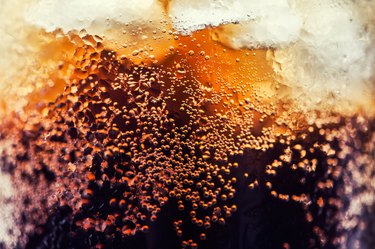
Caramel coloring is one of the oldest and most widely-used food colorings, the same substance that makes your colas brown and gives beers their amber gold. Though it sounds natural, caramel coloring is not the same as the candy confection. There are four types of caramel coloring, two of which containing chemicals implicated in cancer in laboratory animals.
Identification
Video of the Day
The four types of caramel coloring include plain caramel; a type that reacts sugar with sulfites; one that reacts sugars with ammonium compounds; and one that reacts sugars with both ammonium and sulfite compounds — the type of coloring used in most sodas. Caramel coloring is also found in brown bread, chocolate, cough drops, vinegars, custards, fillings, doughnuts, gravy browning and many other food products.
Video of the Day
Blood Pressure
Although colas have been linked to increased high blood pressure, it was thought that the caffeine in the beverages was to blame. However, a 2005 study in the "Journal of the American Medical Association" found that although regular caffeinated coffee drinkers were not more likely to have high blood pressure, regular cola drinkers were. The researchers concluded that another component in the colas was possibly to blame — the caramel coloring rich in harmful advanced glycation end products.
Cancer
The Center for Science in the Public Interest petitioned the Food and Drug Administration in January 2011 to ban two types of caramel coloring that react with ammonia, due to cancerous byproducts they contain known as 2-MEI and 4-MEI. At the same time, the state of California added 4-MEI to its list of chemicals known to cause cancer. Both complaints are based on studies published in 2003 and 2005 by the National Institutes of Health National Toxicology Program that showed the chemicals caused cancer in some mice and rats.
Immune System
Caramel coloring III, the type produced with ammonia but not sulfites, may reduce beneficial white blood cell counts in your bloodstream, according to a study published in "Toxicological Sciences" in 1993. The Dutch researchers fed mice a diet with added caramel coloring III for a month and then measured their immune response to Trichinella spiralis, a microbe that causes the disease trichinosis. The mice given the highest levels of caramel coloring had the largest decreases in immune function.
Allergies
Certain ingredients used in making caramel coloring can cause reactions if you have an allergy to them or have celiac disease or gluten intolerance. Some of these include milk, corn dextrose, corn or wheat starch, and malt syrup derived from barley. However, these ingredients aren't always indicated individually on the product labeling.